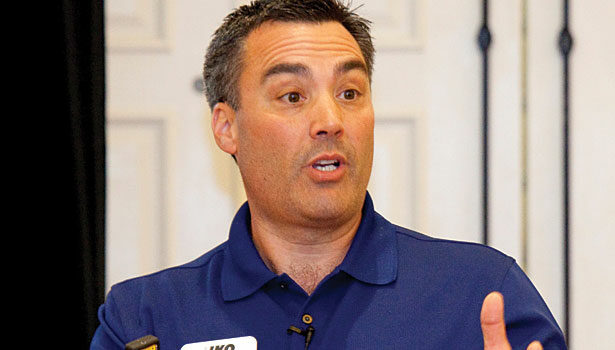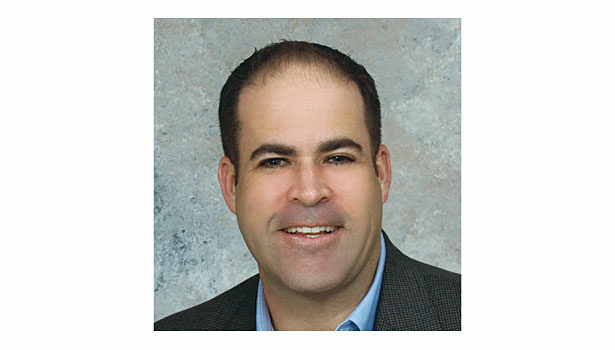2014 State of the Industry Report: Steep-Slope Trends
Steep-Slope Market Focuses on High-End Systems






































| State of the Industry Reports | |||
Homeowners are increasingly aware of the importance of their roof when it comes to curb appeal, and manufacturers, distributors and contractors are bracing for new product offerings in the residential market.
“Roofing contractors should expect to continue seeing an increase in popularity for designer (architectural) asphalt shingles,” said Reed Hitchcock, executive vice president of the Asphalt Roofing Manufacturers Association (ARMA). “Designer shingles are different from other kinds of asphalt shingles in that they contain more than a single layer of tabs; this creates thickness and adds both visual depth to a roof and the beauty of a personalized style. Homeowners are drawn to the ability of designer asphalt shingles to attain the look and curb appeal of alternative roofing materials, but at a more affordable price. In addition to the wider range of available looks, the superior safety ratings and reliability of these shingles will continue to attract homeowners as they become more widely used. Contractors can expect these products to have the same ‘easy to install, easy to repair’ attributes of other asphalt shingles.”
Kirk Villar, vice president of residential sales and marketing for Atlas Roofing, pointed to strong sales of algae-resistant shingles. “Contractors will continue to see new and innovative products introduced during 2014 with the focus being on longer-lasting, better-performing shingles,” he said. “Homeowners continue to see the value laminated, architectural shingles add to the curb appeal of their homes. Manufacturers will take advantage of this trend by making more styles and colors available for architectural shingles.”
|
David Harrison: Be Prepared to Handle the Skeptical Consumer |
|
In 2014, the toughest problem facing residential contractors will be consumers who continue to become more skeptical in their buying decisions. As a result, contractors will need to continue to improve their ability to communicate and differentiate themselves from other options.
There are many things that continue to drive consumers to be more skeptical. Primary factors include the economy, the industry and technology. The economy continues to be uncertain. The sales capabilities of contractors have vastly improved versus even five years ago. And the majority of consumers are now using advanced technology, giving them quicker access to information. The economy has created a strange effect on consumers requiring roofing services. Listening to the news, the statistics are unsettling. While the unemployment rate seemingly is decreasing, it’s masked by the fact that millions of Americans have withdrawn from the search for employment. That’s unsettling. And that means roofing consumers are bombarded with skepticism about the economy. They hear things at work, on the news and in their neighborhoods. This makes consumers jittery, even if they are relatively secure in their own jobs. And when they’re jittery, they’re more skeptical buyers. The industry is another factor requiring contractors to “take it to the next level.” Years ago, a consumer was lucky enough to get a contractor to show up, measure and provide a quote. While “Pete in the pickup” is a concept we continue to talk about, the reality is there are fewer Petes in the market. They have slowly been replaced with professional roofing contractors. If you’re reading this, you’re probably one of them. These contractors have been to training conducted by national roofing manufacturers (like the “Day with Dave” events I used to conduct for GAF). As a result, the consumer is more likely to meet with an estimator who is trained in sales, attempts to educate the consumer and provides a professional-looking proposal. When there were only a few contractors desiring to invest time educating the consumer, it was novel. But with more households with both spouses working, it’s more difficult to get their time. It’s easy to see how consumers might become skeptical — if they get quotes from a few “reputable” contractors, it comes back to price again. And technology has continued to change the dynamics in the home. The resource sites including Angie’s List, Yelp and others help the consumer feel more confident that the quotes they are receiving are essentially equivalent, and therefore they can return to their comfort zone: price. With consumers averaging one hour a day on the Internet, it is amazing how quickly they can network and identify information that makes them feel comfortable in their decisions. So, when things get tough, it’s back to basics with a twist. There are things that haven’t changed. If you don’t differentiate, you’re a commodity. And if you’re a commodity, you’re competing on price. And if you’re competing on price, you better have very low costs and very high volume to make the model work. The driving factors haven’t changed. The entire buying process is based on three sequential requirements. First, establishing trust. Second, sharing useful information that is logical and relevant. And third, “connecting the dots” on WIFFM (what’s in it for me?). What’s in it for me drives essentially all buying decisions. But if they don’t trust you, you can’t educate. And if you can’t educate, you can’t get to the WIIFM. So, the reality for 2014 is more of the same, but even more intense. For those who invest in even better communication with the customer, 2014 will be a good year. For those who don’t, the industry will continue to be frustrating and possibly provide a good paycheck, but not significant wealth. David Harrison is president of Harrison Management Consultants. |
Dan Piché, vice president of national business development for ABC Supply Co., Inc., also pointed to product enhancements. “Manufacturers continue to develop and promote higher-value products with improved performance and enhanced aesthetics, as well as products engineered to increase installation productivity,” he said. “Among them are shingles with a marked, wider nailing strip and products with enhanced warranties. These give contractors additional profit opportunities, along with new, value-added options to offer to their customers. The green movement continues to make progress, albeit slowly, as energy efficient home improvement tax credits expire and the financial incentives to offset the cost-value equation are diminished.”
High-End Options
Dave O’Donnell, president and CEO, NEMEON Inc., has seen more homeowners that are receptive to exploring different high-end options. “With the increases in shingle pricing over the last few years, there are more options in the same price range of asphalt shingles,” he said. “Metal and specialty shingles are becoming a popular choice for the homeowner. A contractor must be aware of the choices and be prepared to discuss with a potential client, as the homeowner is becoming more educated on their choices in steep-slope products on the market today.”
J. Douglas Lanier, president of Collis Roofing Inc., also sees more consumers looking at high-end options and asking about warranty coverage. “As to steep-slope roofing, we see more and more homeowners and builders buying upgraded types of shingles and adding the manufacturers’ warranties to their purchase,” Lanier noted. “To purchase a roof replacement is often a shock to a homeowner, but knowing that for 25-50 years (depending on the manufacturer) it is ‘under warranty’ helps many go ahead and bite the bullet on getting it done. Financing is also a growing trend, as it allows a much smaller out of pocket to get the work done.”
Kayla Kratz, product manager for Boral Roofing, has seen tile specified for more new construction projects. “New home construction is steadily growing, and clay and concrete roof tile are gaining market adoption due to performance, aesthetics and durability.”
Bill Baley, president of C.I. Services Inc., noted that re-using tile has become a focus in re-roofing. “Here in the California market, we are seeing a trend toward tile re-roof projects where the existing tile is being saved and the underlayment replaced,” he said. “It’s still good work, but if you are not familiar with it, learn how to do it efficiently and you will see that there is good money in these replacements.”
Douglas Sutter, president of Sutter Roofing Company of Florida, has noted an uptick in residential metal. “We are seeing more metal roofing specified than in recent years,” he said. “I believe that is mainly due to design professionals not wanting to do a typical Mediterranean-influenced building and create something more contemporary and unique.”
The Metal Market
Metal roofing is one area in which a number of commentators expect growth in both residential and commercial applications. Geoff Stone, CEO of MetalForming Inc., anticipates slow, steady growth in the metal segment. “Residential has already picked up,” he said. “Metal was already gaining market share there, though the recession sort of stopped us cold in the residential area. Generally speaking, metal roofing and walls are going on higher-end homes. I think that will restart now that the jumbo mortgage market has loosened. New multifamily construction is also an area where we should gain share. And while we haven’t yet seen a significant uptick in nonresidential, nongovernmental building, we would anticipate that as the economy normalizes, there is going to be some pent-up demand, and we’ll start to see some real increase there as well.”
Stone urged contractors to be aware of trends in front-end automation. “From the capital goods side of the business, they need to be aware of applications and processes that substantially increase the productivity of their people,” he said. “These are things like being able to draw up trim profiles at the jobsite and download them to the machine to directly produce the parts. They include trends like the development of digital measuring techniques that could save them time and money. They should be looking at the development of all kinds of applications to substantially increase their productivity.”
Bill Hippard, president of the Metal Roofing Alliance, believes explaining the concept of lifecycle cost is the key to educating building owners about metal roofing. “Selling the value of metal roofing and discussing the many benefits and lifecycle costs of metal roofing is critical in making the sale,” he said “Longevity continues to be one of the top reasons consumers report choosing metal roofing for their homes. When configured and installed properly by an MRA member contractor, metal roofing can last as long as 50 years or more, requiring very little maintenance while remaining beautiful. But it isn’t just the dependability that people love about long-living metal roofing; it’s the low lifecycle cost.”
Brett Hall, president of Joe Hall Roofing Inc., agrees that educating the customer is essential. “Metal continues to grow and grow,” he said. “Any customers considering metal roof systems generally have a mountain of information to understand before being qualified to make a choice. For contractors, the process of defining the customer is critical. Many times we find out quickly that an opportunity is really an exercise in bidding. The act of ‘quizzing down’ the customer has proven advantageous in saving time and moving that time resource to opportunities that will produce sales. A personal note is that out of 100 interested, 5 percent will choose metal as their final choice. All metal products are continuing to gain market share.”
Todd E. Miller, president of Isaiah Industries and past chair of the Metal Construction Association (MCA), urged contractors to educate themselves on manufacturers’ warranties.
“I have noticed a lot of changes in product warranties throughout the building materials industry,” he said. “Contractors need to make sure that they understand the warranties being provided by manufacturers, and that they can properly explain those warranties to consumers. From what I have seen, the metals industry still leads the way in terms of how comprehensive our warranties are.”
Roger Moore, director of marketing and product support manager, Novagard Solutions Inc., noted that the performance of the adhesive used was a key consideration with any metal roof system. “The metal roof segment, we know, is growing fast, but growth of our Novaflex Metal Roof Sealant has surpassed the market,” he said. “Sales have doubled each of the last three years. We anticipate continued strong growth of the metal roof segment and Novaflex growing even faster.”
|
John DeRosa Jr.: Three Things to Focus on in 2014 |
|
One of the toughest challenges facing contractors today is the simple fact that their prospective customers are literally one mouse click away from the competition. This challenging reality makes it that much more important for contractors to focus on the following areas:
1. Be findable: Contractor websites need to be bursting with content specific to the most popular keywords customers are using to search for their products or services. When I refer to content, I’m talking not only about the text on your webpage, but also the images and videos you use to enhance the look of the page. I’m a huge fan of incorporating videos into your online branding strategy. In addition to helping you boost your Google ranking, they will also serve to differentiate you from the many contractors who are not using videos. Remember, people buy from people, and short of being there in person, there is nothing more powerful than video to convey the unique factors that differentiate you from your competition. 2. Convert visitors into leads: Assuming we’re successful in getting prospective customers to find and visit our website, it’s imperative that we create a condition that moves the users into the conversion funnel and turns them into a lead. CTAs (i.e., “calls to action”) should be an integral part of your website’s landing page. Giving your visitors an invitation to enter a contest, get a price, download a coupon or participate in a survey is an excellent way to engage the prospects and start relationships with them. 3. Be the first to respond: Speed-to-call is the single largest driver of lead conversion, according to a November 2012 report from Leads360. The study reports that simply calling a prospect within a minute of lead generation can increase the likelihood of conversion by 391 percent. This drops to 160 percent after two minutes, 98 percent after three minutes, 62 percent after 30 minutes, 36 percent after an hour, 24 percent after five hours and 17 percent after 24 hours. Contractors need to put systems in place to ensure an immediate and professional response to all inquiries. It’s sad to think of all the effort that went into generating the lead and the likelihood of conversion reduces exponentially when we don’t respond instantaneously. Roofing projects are not hobby driven, which makes it critically important that those with needs find us, contact us and get the instant response they are looking for. Just remember, your competition is literally one mouse click away. For more information on using video or to obtain a list of “CTA Do’s and Don’ts,” please feel free to email me at john.derosa@iko.com. John DeRosa Jr. is manager of sales and contractor development for IKO Industries. |
Tom Dyszkiewicz, senior vice president of sales and marketing, Englert Inc., summed it up this way: “On the residential side, people are staying in their homes longer and are looking for products with lasting durability, supported by strong product warrantees. The metal roofing industry has done an excellent job positioning its products to consumers, targeting issues like aesthetics, hurricane performance, cost and environmental concerns like reflectivity and recyclability. So expect to see more homeowners — particularly in the 2,500 to 5,000 square foot market — opting for metal. This includes geographic areas like the mid-South where the job market is healthy again, and large developers and custom-home builders are meeting a renewed demand for housing.”
Pricing Concerns and Cash Flow
John McLaughlin, president of exterior products for Allied Building Products, advised contractors to brace for a few financial issues in the year ahead, including rising prices due to inflation. “Cash flow could be an issue, as money is tight,” he said. “Steep-slope contractors will have to watch their margins, as competitiveness increases in a down market.”
Richard Spanton Jr., founder and CEO of Mastercraft Exteriors, AccuLynx.com and Storm Solutions, also urged contractors to keep an eye on material costs. “In my opinion, rising material cost is always a trend I follow,” he said. “I would recommend staying close to pricing in all roofing categories a contractor provides. The difference of 2, 3 or even 5 percent is huge in this highly competitive market. One change in cost could kill an individual job — or even worse, the entire company profit.”
“Pricing will continue to rise,” said Ken Kelly, president of Kelly Roofing. “Insurance companies are becoming increasingly more difficult to work with. Stay ahead of the curve and ensure the pricing to your customers is accurate.”
Reaching Homeowners
Brian Chambers, vice president and general manager, roofing and asphalt for Owens Corning, believes selling a roof as a system is the key to reaching today’s consumer. “Homeowners are more educated than ever before about their choices in protecting their biggest asset, their home,” Chambers said. “They understand more and more the value of having a roofing system that includes components designed to work together to provide performance and peace of mind. Our Owens Corning Total Protection Roofing System™ provides homeowners with a system that combines performance with the aesthetic options that homeowners also expect. For roofing contractors, we believe that understanding the value and benefits of installing a roofing system and being able to effectively tell that story in the home will be an increasingly important part of their selling process.”
Kevin Gwaltney, president of Diamond Roofing, also believes in educating the consumer. “I believe homeowners want to purchase a roof using quality materials and superior workmanship, and are willing to pay for it,” he said. “The key to selling this value-added work is to properly demonstrate and communicate your company’s ability to exceed their expectations.”
Chris Barrow, president and CEO of EagleView Technologies, believes technology has changed the way consumers make decisions. “Speed in delivering accurate information to customers will be a strong trend in 2014,” he said. “Homeowners are using the Internet to research their new roof. They know what shingles they want, they know how long it should take, and they know the questions to ask. Contractors will need to utilize technology to deliver bids quickly, accurately and in the way the owner wants.”
Technology can be crucial, noted Barrow. “Successful steep-slope contractors are utilizing technical solutions, such as aerial measurements, that are allowing them to quickly deliver a very accurate professional bid, and then work directly with distribution and manufacturing to deliver accurate materials, superior installation and strong warranties,” he said. “From lead tracking to cloud-based software as a service to mobile solutions, contractors will engage with homeowners in a whole new way.”
Looking for a reprint of this article?
From high-res PDFs to custom plaques, order your copy today!






















